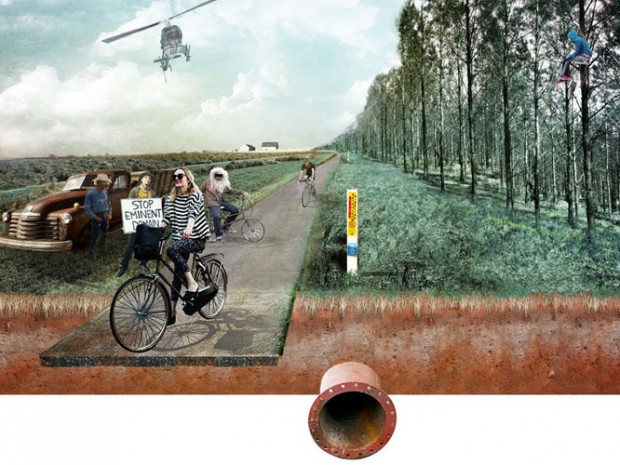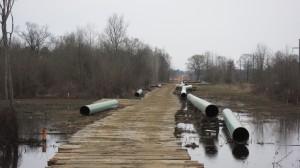Why Can’t Pipelines Also Be Bike Paths?

Courtesy of SWA Group
One Houston firm's idea would give tar sands protesters another option for their commute.
Houston Landscape Architecture Firm Pushes Concept of Keystone XL Right-of-Way for Use as Bike Path
As a North American oil boom has taken off in the U.S. and Canada, so has the need to move that oil to refineries, many of which are in Texas. And the cheapest, most efficient way to do so is pipelines. But as those pipelines proliferate, so do issues over safety, like the spill that took over a neighborhood in Arkansas earlier this year. There are also conflicts over property rights, including several landowners in Texas who have fought companies who want to route private pipelines through their land.

Photo by Terrence Henry/StateImpact Texas
The Keystone XL pipeline under construction in East Texas in the Spring of 2013.
Those pipelines can cut a large swath through property, with an easement 50-feet wide. As you can see in the photo to the right of the Keystone XL pipeline under construction in Northeast Texas, it’s like building a road. And once the pipeline is in the ground, there’s not very much you can do with it. You can’t build any permanent structures on it, for instance.
One landscape architectural firm in Houston has an unorthodox idea: What if you took that massive pipeline right-of-way, going all the way from the Canada to the Texas Gulf Coast, and co-opted it for use as a bike lane?
It’s an admittedly “tongue-in-cheek proposal,” the firm SWA Group admits in its presentation, but it does get you thinking.
The idea — released earlier this Spring and reported on this week in Bloomberg — would make the Keystone XL a giant bike path. “We thought that if they are going to develop 5000 miles of infrastructure, we might get 5000 miles of bike paths out of the project,” the firm writes in its proposal. While heavy oil flows under the surface, carbon-free wheels could spin above ground. “They imagine families taking summer trips along the path, stopping at oft-overlooked cultural and natural heritage sites and spending much-needed tourist dollars along the way,” Fast Company Design wrote of the proposal earlier this year.

Image courtesy of SWA Group
The idea from SWA group imagines boy scout troops biking happily along while diluted bitumen flows underneath them.
Taking unused infrastructure and turning it into recreational attractions isn’t an unheard of idea, however. There’s the High Line in New York, which took an old elevated railroad track and turned it into an urban oasis for walking. (And raised property values and attracted retail businesses as a result.) The firm behind the Keystone XL bike path idea is at work on converting parts of the Buffalo Bayou in Houston from a former urban sewer into a peaceful promenade and turning an old concrete watershed in Los Angeles into a park. (For more on the trend, check out this 2011 Atlantic piece, ‘Transforming Blight Into a Destination.’)
But pipelines aren’t abandoned train tracks. A spokesperson for TransCanada, the company behind the Keystone XL pipeline, tells Bloomberg “to make sure we can maintain or access the pipeline, permanent structures couldn’t be built in the easement.” While the company doesn’t technically own the land, it does restrict what landowners can do on the easements. As we’ve reported earlier, property owners with the pipeline on their land are “limited to not building permanent structures and deep-rooted trees/shrubs” but driving “common farm equipment such as tractors and combines” over a pipeline easement is “not a problem,” according to TransCanada. So theoretically, the pipeline could more than handle some bikes going over it. But whether or not it could be paved seems to be open to debate.
Yet environmental groups aren’t enthusiastic about the idea, either, arguing it would pave over their concerns about spills and safety. And cost? The estimated price tag for such a project is $400 million. That’s roughly 5 percent of the overall $7 billion cost of the Keystone XL pipeline project.
“If it’s going to be built—then as designers, we’ve got to challenge the concept and say, well, we want something in return. We want something better from it,” the firm says in its presentation. And if a bike plan could ostensibly work for the Keystone XL pipeline, it could ostensibly work for some of the millions of miles of other pipelines in the country. Not to mention all that land under power lines.
That’s already happening in Texas. A bill that would help move forward “bicycle interstates” under power lines in Houston passed the state legislature this year and was signed into law by Governor Rick Perry.That bill removed liability for power companies for bike trails underneath their lines, opening up over a hundred miles in the Houston area for bike paths that can be constructed much more cheaply than traditional paths. Perhaps something similar could happen for the Keystone XL pipeline in the future.

